Mehrnaz Doustmohammadi1, Sumalatha Kesavareddy1, Michael Anderson1, Sampson Gholston2
1Civil Engineering, University of Alabama in Huntsville, Huntsville, United States
2Industrial Engineering and System Engineering and Engineering Management, University of Alabama in Huntsville, Huntsville, United States
Correspondence to: Mehrnaz Doustmohammadi, Civil Engineering, University of Alabama in Huntsville, Huntsville, United States.
| Email: |  |
Copyright © 2017 Scientific & Academic Publishing. All Rights Reserved.
This work is licensed under the Creative Commons Attribution International License (CC BY).
http://creativecommons.org/licenses/by/4.0/

Abstract
Drivers who are unfamiliar with the roadways, locations of destinations, and generally distracted by the newness of the surrounding are assumed to have different crash experiences, both with respect to causes and conditions. This paper examines crash experiences from five year of crashes for two communities in Alabama to determine if there is a significant difference in crash variables between different driver populations, out-of-state drivers versus in-state drivers and out-of-town drivers versus local drivers. The data were analyzed using two statistical tests to evaluate the difference in crashes. The results show that out-of-state and out-of-town drivers tend to have significant seasonal differences depending on the community, have different types of crashes that tend to be focused on distracted driving and possibly searching behavior and different driver age for the crash depending on the location. Interesting to note, other environmental factors such as weather had no significant influence on crashes for the communities. Overall, the crashes were determined to be based on distractions and inattentiveness of the driver unfamiliar with the roadway and community.
Keywords:
Tourist crashes, Small communities, Crash analysis
Cite this paper: Mehrnaz Doustmohammadi, Sumalatha Kesavareddy, Michael Anderson, Sampson Gholston, Examining Crashes for Out-of-State and Out-of-Town Drivers: A Study of Two Locations in Alabama, International Journal of Traffic and Transportation Engineering, Vol. 6 No. 3, 2017, pp. 64-70. doi: 10.5923/j.ijtte.20170603.03.
1. Introduction and Background
Driving in communities where you are unfamiliar with the roadways and locations of signs and signals can potentially lead an increase in crashes or can potentially lead to a decrease in crashes. The increase in crashes is hypothesized based on the fact that the drivers not familiar with the community will be distracted by visual aspects of the community and will drive differently as they are seeking unfamiliar locations, hotels, restaurants, etc. The decrease in crashes is hypothesized based on the fact that drivers not familiar with the community will drive more cautiously, obeying traffic laws, and will notice signs and signals local drivers often overlook. This paper seeks to identify which hypothesis is correct and make assessment as to why crashes for unfamiliar drivers are different.These out of town drivers, or tourists, and their driving characteristics have been included in traffic engineering operation analysis through the driver population factor as these drivers disrupt the normal flow of travel from drivers who know the area thoroughly [1]. Therefore, it is expected that these drivers will have different crashes and expectations of causes and types of crashes.Several studies of crashes for tourists have focused on fatalities and injuries in Australia [2-4]. These studies have concluded that the majority of the crashes are attributable to driving in unfamiliar surroundings. Another paper examined crash experience in Southeast Asia and concluded similarly that the unfamiliarity of the roadway contributed to the crash [5]. A study of drivers in New Zealand concluded that there is a higher percentage of fatal and injury crashes with overseas drivers than the typical percentage of traffic crashes for all drivers, indicating that overseas drivers are likely to have more severe crashes than local drivers [6]. A study in Greece concluded that the traffic injuries were greater than local residence due to excess risk taken by drivers [7]. A study in the Balearics (Spain) concluded that weather tended to have a contributing impact on the number of crashes experienced by tourist to the location [8]. There was a lack of study examining crashes for out of town drivers in the United States cities leading to this study.This study examines the crashes for two areas/cities in Alabama. The first is Selma and the second is the combined cities of Gulf Shores and Orange Beach, referred to as The Beach for this paper, See “Figure 1” for locations of the communities within the state. These areas/cities were selected to represent two unique communities in Alabama that have different potential for tourists. Due to the historic nature of Selma, Alabama and the Gulf of Mexico access for The Beach. Examining the similarities of the two communities, the population for Selma, AL was 20,756 according to the 2010 census [9] and the combined population of The Beach was 15,182 according to the 2010 census [10, 11].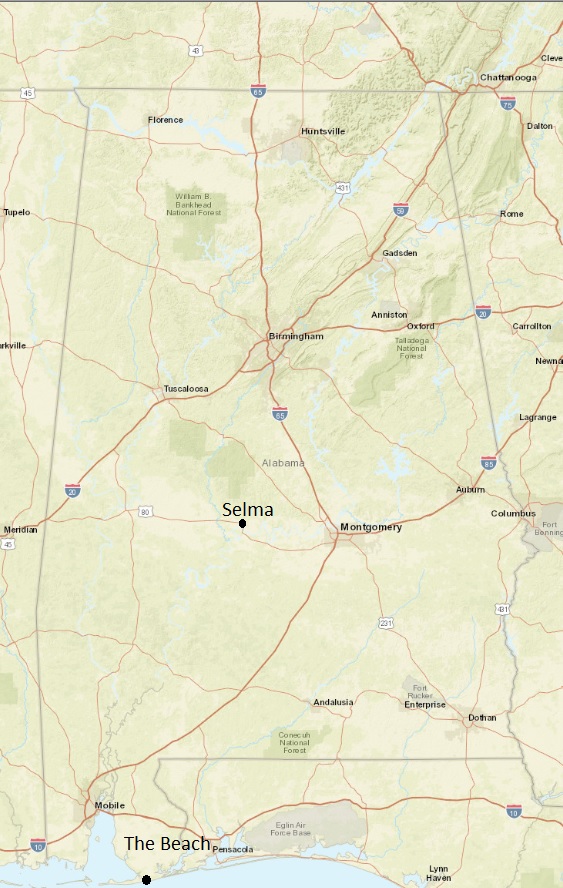 | Figure 1. City Locations |
This paper examines the differences in crashes between local drivers and out of town/out of state drivers in a community. The analysis is based on crashes collected from the Critical Analysis Reporting Environment (CARE) crash database maintained by the Center for Advanced Public Safety at the University of Alabama. The database contains several crash parameters that will be used to determine the differences between drivers from Alabama and those from outside Alabama as well as drivers from Alabama who live within 25 miles of the crash location and those who live greater than 25 miles from the crash location. Specific data elements that will be examined will include the cause of the crash, severity of the crash, age of the driver, among others. The results of the paper include the differences in crashes to determine what difficulties tourists are having driving in the two communities and how tourists in the two communities are having differences.
2. Study Design
The study to compare crashes between local drivers to out of town and out of state drivers examined the difference in recorded crash data for crashes occurring in the two areas. As mentioned, the data were taken from CARE database for the communities and examined to determine similarities and differences between the two driver classifications. Essentially, a matrix of crash statistics was developed and compared on numerous variables, see Table 1.Table 1. Analysis for this Paper
 |
| |
|
The crash data examined in the paper from CARE includes the following variables:Ÿ Month of Crash – this variable documents the month for the crash to determine if there are temporal difference in crashesο January through December Ÿ Primary Contributing Circumstance – this variable identified the cause of the crash as indicated by the report officer – the data were grouped as follows:ο Aggressive driving, Distraction, Failure to yield, Failure to Yield at traffic control, Followed to close, Improper maneuver, sight distanceŸ First Harmful Event – this variable identifies the object which the vehicle crashed into or if it was a single vehicle crashο Collision with vehicle in traffic, Collision with an object, Ran off roadŸ Manner of Crash – this variable identifies the portion of the vehicle involved in the crashο Angle (front to side) opposite direction, Angle (front to side) same direction, Angle oncoming (frontal), Vehicle backing: rear to rear , Vehicle backing: rear to side, Head-on (front to front only), Rear end (front to rear), Side impact (90 degree), Side impact (angled), Sideswipe (opposite direction), Sideswipe (same direction), Single vehicle crashŸ Crash Severity – this variable identified the level of crashο Fatal injury, Incapacitating injury, Non-incapacitation injury, Possible injury, Property damage onlyŸ Lighting conditions – this variable indicated the level of vision at the time of the crashο Dark (roadway not lighted), Dawn, Daylight, Dusk, Dark (continuous lighting), Dark (spot illumination both side of road), Dark (spot illumination one side) Ÿ Weather – this variable is the current weather at the time of crashο Clear, Cloudy, Mist, RainŸ Driver Age– this is the age of the driver causing the crashο 16, 17, 28, 19, 20, 21, 22-24, 25-34, 35-44, 45-54, 55-64, 65-74, 75 and olderŸ Vehicle Maneuver – this variable is a report of how the driver was operating the vehicle at the time of the crashο Backing, Changing lanes, Entering main road, Stopped for sign/signal, Making U-turn, Movement essentially straight, Slowing/stopping, Turning left, Turning rightŸ Roadway condition – this variable is an indication of the pavementο Wet, Dry Ÿ Roadway Curvature and Grade – this variable is a summary of the geometric layout of the roadway at the location of the crashο Curve left and level, Curve right and level, Straight and level, Straight with downgrade, Straight with downgrade, Straight with upgrade The crash data were not identified for selected roadways and therefore there is no indication of actual roadway the crash occurred, the analysis is performed for the entire communities.
3. Data Analysis
The analysis of the crash data was performed using a chi-square test to determine if there was difference in reported crashes for the various variables examining the difference classifications [12]. For instances where there was a significant difference in the variables, a 2-proportion test was performed to determine which characteristics of the variables were actually different [12]. The following sections of the paper provide the results of the tests for the different options identified in Table 1.
3.1. Out-of-State versus Alabama Drivers
The first three analyses performed focused on out-of-state versus Alabama drivers. As mentioned, a chi square test was performed on the data to determine which variables showed a significant difference in crashes between the two populations. See Table 2.Table 2. Chi-Square Test Results for Out-of-state Versus Alabama Drivers
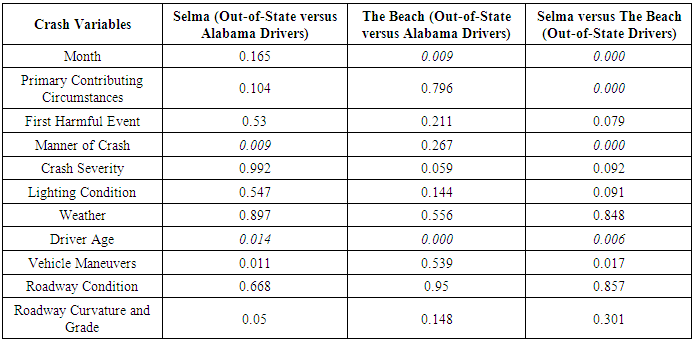 |
| |
|
3.1.1. Selma: Alabama versus Non-Alabama
The first analysis performed was a comparison of driver from different states who experienced crashes in Selma, AL. The states where drivers were licensed who had crashes in Selma are show in “Figure 2.” As mentioned, a chi-square test was used to identify if there were significant differences between the crashes for the two populations (Alabama drivers and non-Alabama drivers). A subsequent 2-proportion test was performed to determine which population had the larger difference. From the test, the results obtained are shown in Table 2 and Table 3.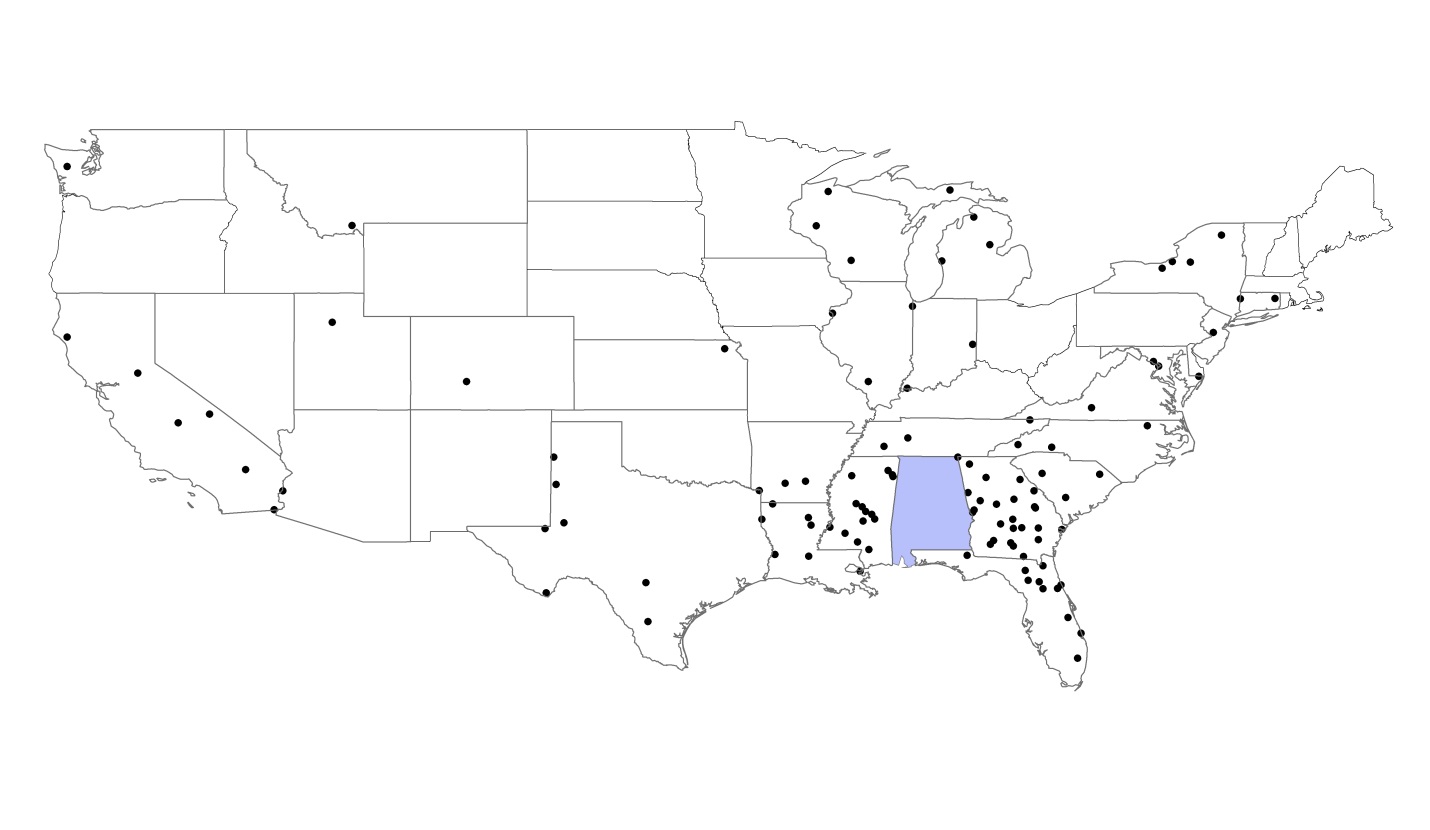 | Figure 2. Out-of-State Driver’s Home State that Crashed in Selma, AL |
Table 3. 2-Proportion Test Results
 |
| |
|
From Table 2, the key measures that differ between out of state drivers and Alabama drivers are manner of crash and driver age. From Table 3, the manner of crash, the out-of-state residents are more likely to be the cause of sideswipe (same direction) and less likely to be the cause of side impact (90 degrees) crashes. The likelihood of increases in sideswipe same direction crashes for non-Alabama residents could be due to drifting in lanes when searching for locations and unfamiliarity of the roadway system. It is interesting to note that the Alabama driver’s manner of crash didn’t impact crash severity, it is theorized that although the Alabama residents had more side impact crashes, these crashes probably took place on lower speed roadways and therefore didn’t lead to higher severity crashes. For driver age, older drivers from out-of-state were the cause of more crashes in Selma than that population of Alabama residents. These drives might be from the population of drivers that are recent retirees traveling through Selma at a higher rate than local residents and having increases in crashes.
3.1.2. The Beach: Alabama versus Non-Alabama
The second analysis performed was a comparison of driver from different states who experienced crashes in two communities being called The Beach, AL. The states where drivers were licensed who had crashes in The Beach are shown in “Figure 3.” As mentioned, a chi-square test was used to identify if there were significant differences between the crashes for the two populations (Alabama drivers and non-Alabama drivers). A subsequent 2-proportion test was performed to determine which population had the larger difference. From the test, the results obtained are shown in Table 2 and Table 4.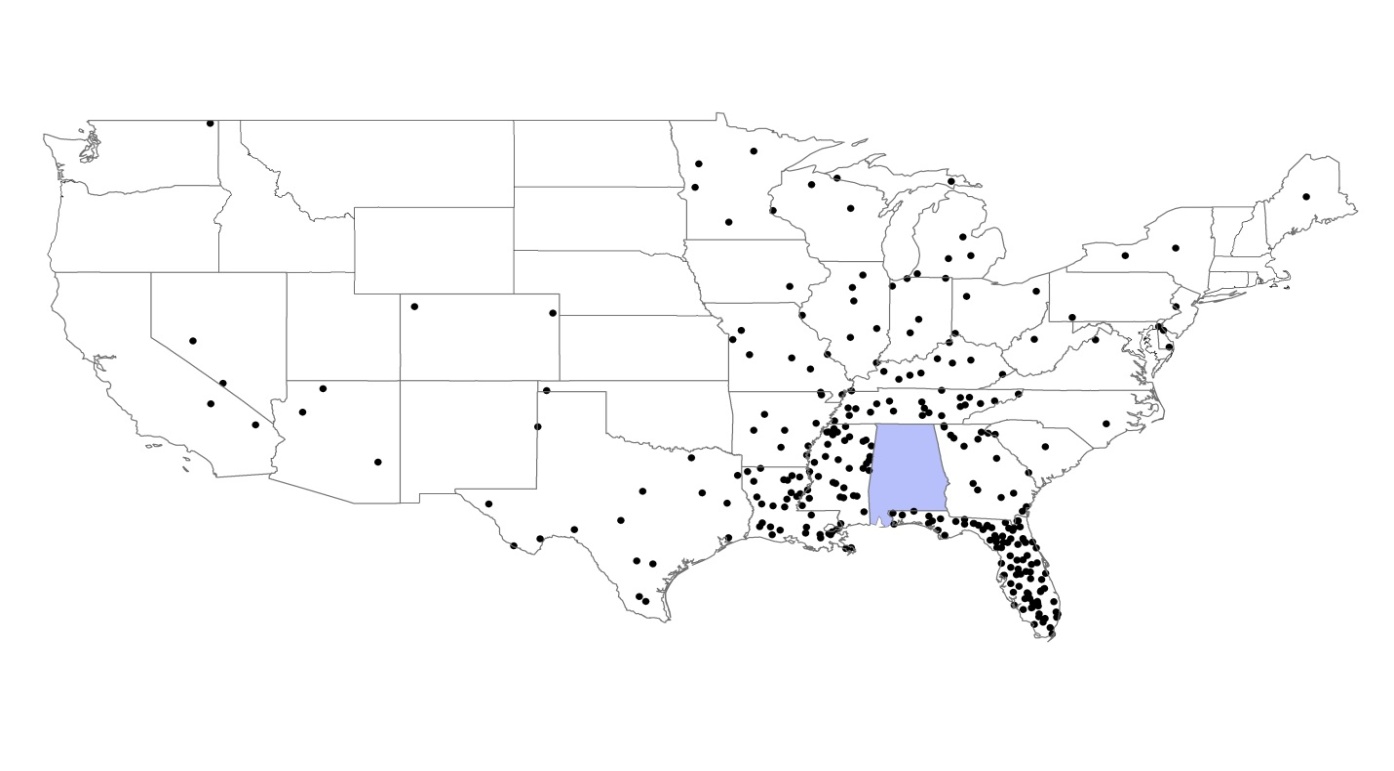 | Figure 3. Out-of-State Driver’s Home State that Crashed in The Beach, AL |
Table 4. 2-Proportion Test Results
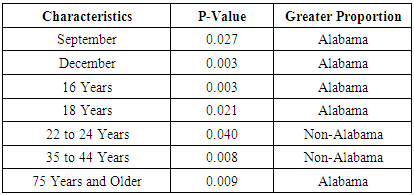 |
| |
|
From Table 2, the key measures that differ between out of state drivers and Alabama drivers are month and driver age. From Table 4, Alabama residents tended to have higher rates of crashes in September and December, likely when many out-of-state residences would not be visiting The Beach community. For driver age, the likelihood of crashes was higher for college age students (presumably spring break) and parents who would likely have young children visiting The Beach for summer vacations.
3.1.3. Comparison of Out-of-State Drivers
The third comparison made was between non-Alabama drivers within the two communities. This comparison was made to determine if there were differences in out-of-state driver crashes. The hypothesis is that out-of-state drivers in The Beach will have different causes for the accidents because of the differences in visual distractions and differences in drivers in the two communities. The results obtained are shown in Table 2 and Table 5.Table 5. 2-Proportion Test Results
 |
| |
|
From Table 2, all the key measures differ between out of state drivers when comparing the two cities. From Table 5, the month shows the impact of summer vacation travel. The rear end crashes indication an increase in non-focused driving, or distracted driving, at The Beach. Examining the cause of the crash, The Beach tended to have causes more likely associated with distractions versus Selma and rear end crashes associated with flowing too closely and distracted driving. Driver age indicates that younger people are potentially more likely to visit The Beach which older drivers are potentially more likely to visit Selma.
3.2. Out-of-Town versus Local Drivers
The second three analyses performed focused on out-of-town versus local drivers. As mentioned, a chi square test was performed on the data to determine which variables showed a significant difference in crashes between the two populations. See Table 6.
3.2.1. Selma: Local Drivers Versus Out-of-Town Drivers
The fourth analysis performed was a comparison of crashes from Alabama and their distance to the community, Selma, Alabama. These drivers were identified in the CARE database as being the residence within 25 miles of the crash (referred to as local drivers) and those from out-side of 25 miles (referred as out-of-town drivers). All drivers not from Alabama were removed from the analysis. As mentioned, a chi-square test was used to identify if there were significant differences between the crashes for the two populations (Local drivers and out-of-town). A subsequent 2-proportion test was performed to determine which population had the larger difference. From the test, the results obtained are shown in Table 6 and Table 7.Table 6. Chi-square test results
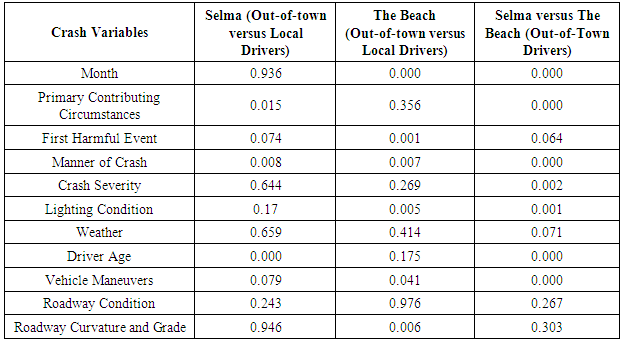 |
| |
|
Table 7. 2-Proportion Test Results
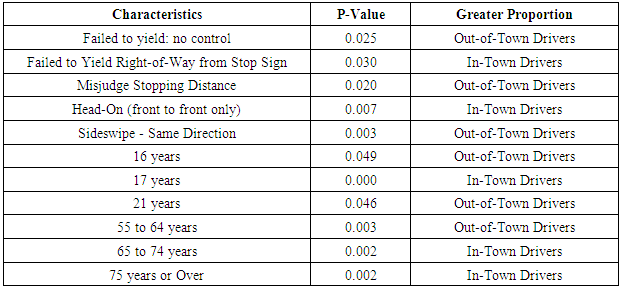 |
| |
|
From Table 6, the key measures that differ between local drivers and out-of-town drivers are primary contributing circumstance, manner of crash and driver age. From Table 7, out-of-town drivers in Selma tended to have crashes from no control intersections while local drivers tended to have crashes from stop signs. This result makes sense as out-of-town drivers are more likely exiting onto the main roadways from businesses than driving on local city streets where stop signs are prevalent. The result that out-of-town drivers tended to misjudge stopping distance due to unfamiliar knowledge of the roadways and potentially not paying full attention to the roadway environment as well as having more sideswipe accidents due to lane drifting. The local drivers having a greater number of crashes for driver over 65 is also logical as there are more drivers in this age category likely to be driving in the community and fewer elderly people traveling 25 miles to get to Selma.
3.2.2. The Beach: Local Drivers versus Out-of-Town Drivers
The fifth analysis performed was a comparison of driver from Alabama and their distance to the community, The Beach, Alabama. These drivers were identified in the CARE database as being within 25 miles of the crash (referred to as local drivers) and those from outside of 25 miles (referred to as out-of-town drivers). Out-of-state crashes were removed from the analysis. As mentioned, a chi-square test was used to identify if there were significant differences between the crashes for the two populations (Local drivers and out-of-town drivers). A subsequent 2-proportion test was performed to determine which population had the larger difference. From the test, the results obtained are shown in Table 6 and Table 8.Table 8. 2-Proportion Test Results
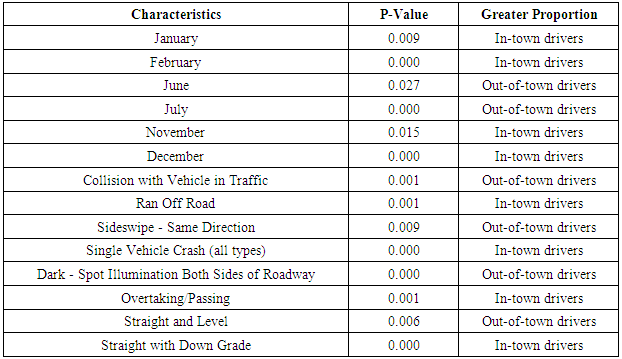 |
| |
|
From Table 6, the key measures that differ between local and out-of-towndrivers are month, first harmful event, manner of crash, lighting condition, vehicle maneuver and roadway curvature and grade. From Table 8, the month of the crash contribution between local and out-of-town drivers fits the seasonal expectation of The Beach community. Summer months will see a higher number of crashes by residents vacationing in the area and the winter months the expectation is to see a greater number of local residents having crashes. The first harmful event indicates that out-of-town drivers are more likely to have crashes where they hit another vehicle, again probably due to lack of focus on the roadway and more visual distractions. The in-town drivers tend to have more crashes overtaking/passing other vehicles. This is likely do to local drivers being impatient with out-of-town drivers potentially driving slowly and making erratic maneuvers when looking for locations.
3.2.3. Selma and the Beach: Comparison of Out-of-Town Drivers
The sixth comparison made was between out-of-town drivers the two communities. This comparison was made to determine if there were differences in out-of-town driver crashes. From the test, the results obtained are shown in Table 6 and Table 9.Table 9. 2-Proportion Test Results
 |
| |
|
From Table 6, all the key measures differ between out-of-town drivers when comparing the two cities except first harmful event, weather, roadway condition and roadway curvature and grade. From Table 10, the trend of summer vacationers is again shown. The cause of the crash follows that The Beach would have a higher instance of DUI and distraction. The Beach was more likely to have rear end crashes possibly due to driver distraction while Selma was shown to have higher number of possible injuries, due to the lack of congestion and higher speeds on the roadways where The Beach had more property damage only crashes.
4. Conclusions
This paper presented a summary of crashes for out-of-town and out-of-state drivers in two Alabama communities to examine the difference in crashes between these drivers and local drivers. The two cities selected were similar in population and number of crashes, but represented two distinct driver populations. One is a vacation destination community where a significant number of out-of-town and out-of-state drivers visit during the summer months and the other is a typical town in rural western Alabama, although the largest town for 40 miles in any direction.Items that were similar between all the analyses performed were the impact of weather and roadway condition. These environmental factors examining the impact of rain and water, or wetness, of the pavement, didn’t contribute to differences in crash rates between any of the driver classifications considered. As shown in the analysis, The Beach community tended to have more crashes during the summer months, by younger drivers and crashes that can be expected to be caused by inattention to driving and lack of knowledge of the roadway system and surrounding area. Selma tended to have more crashes by older drivers and tended to follow the local driver more closely. It is theorized that the out-of-town drivers in Selma were more likely individuals who tended to travel to Selma on a more regular basis for shopping and other needs while the out-of-town drivers in The Beach were more vacationers, and while they may have been to the area in previous years, do not drive in the community on a regular basis.The overall conclusion of this study is that drivers who do not use the roadways frequently tend to have different crashes caused by different purposes. Therefore, it is important to address crash counter-measures different to be reflective of the community and the drivers within the community as there are differences depending on the location and nature of the travel.
References
| [1] | Roess, Roger P., Elena S. Prassas, and William R. McShane. Traffic Engineering. Upper Saddle River, NJ: Pearson/Prentice Hall, 2011. |
| [2] | Wilks, Jeffrey, Barry C. Watson, and Ian J. Faulks. "International tourists and road safety in Australia: developing a national research and management programme." Tourism Management 20.5 (1999): 645-654. |
| [3] | Wilks, Jeffrey, Michael Coory, and Barry C. Watson. "Hospital admissions for overseas visitors involved in motor vehicle crashes in Queensland, Australia." Asia Pacific Journal of Transport 3.1 (2000): 7-14. |
| [4] | Mitchell, Rebecca J., Ann Williamson, and Amy ZQ Chung. "Comparison of injuries experienced by international tourists visiting Australia and Australian residents." Asia-Pacific Journal of Public Health 27.2 (2015): NP1683-NP1694. |
| [5] | Hongsranagon, Prathurng. "Pilot study of types of casualty crashes experienced by tourists in a Southeast Asian destination." Road & Transport Research: A Journal of Australian and New Zealand Research and Practice 20.4 (2011): 84. |
| [6] | New Zealand. Ministry of Transport. Overseas driver crashes 2015. 2015. Accessed June 28, 2016. https://0x9.me/dQJK1. |
| [7] | Petridou, Eleni, et al. "Are traffic injuries disproportionally more common among tourists in Greece? Struggling with incomplete data." Accident Analysis & Prevention 31.6 (1999): 611-615. |
| [8] | Rosselló, Jaume, and Oscar Saenz-de-Miera. "Road accidents and tourism: the case of the Balearic Islands (Spain)." Accident Analysis & Prevention 43.3 (2011): 675-683. |
| [9] | “U.S. Census Bureau QuickFacts selected: Selma city, Alabama.” United States Census Bureau. Accessed June 28, 2016. http://www.census.gov/quickfacts/table/PST045215/0169120. |
| [10] | “U.S. Census Bureau QuickFacts selected: Orange Beach city, Alabama; Selma city, Alabama.” United States Census Bureau. Accessed June 28, 2016. http://www.census.gov/quickfacts/table/PST045215/0157144,0169120. |
| [11] | “U.S. Census Bureau QuickFacts selected: Gulf Shores city, Alabama; Orange Beach city, Alabama; Selma city, Alabama.” United States Census Bureau. Accessed June 28, 2016. http://www.census.gov/quickfacts/table/PST045215/0132272,0157144,0169120. |
| [12] | Montgomery, Douglas C. and George C. Runger. Applied Statistics and Probability for Engineers. John Wiley & Sons, 2010. |






 Abstract
Abstract Reference
Reference Full-Text PDF
Full-Text PDF Full-text HTML
Full-text HTML







